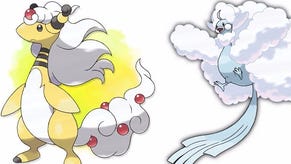Pok¨Śmon Sun and Moon EVs - the best EV training locations for every stat and EV training in Ultra Sun and Ultra Moon explained
Everything you need to know about EVs, including how and were to EV train in Sun and Moon.
EV training is back again in Pokémon Sun and Moon and Ultra Sun and Ultra Moon, and is as important as ever for the competitive player.
Here on this page, we'll be explaining how EV training works, what EVs are, and most importantly for players who already know the basics, the best EV training locations in Pokémon Sun and Moon.
For more on competitive Pokémon meanwhile, head back to our main Sun and Moon competitive training guide, or take a look at our pages on IVs and base stats explained, Breeding and how to pass on Egg Moves, IVs, Abilities, Natures, and Poké Balls, and our explainer on the best way to farm Bottle Caps and Hyper Training.
Note that, as of Pokémon Ultra Sun and Ultra Moon's release, we're still updating this page to double check all of the below methods work. In theory though they're all the same - so don't expect many changes!
Pokémon Sun and Moon EVs explained - what are EVs and how to Effort Values work in Ultra Sun and Ultra Moon?
EVs, short for Effort Values, are the hidden numbers which help define the strength of a Pokémon's given stat. Whilst their counterpart, IVs, dictate a Pokémon's inherent strength, and Natures provide a small modifier on certian stats, EVs denote the amount of training a Pokémon has in the stat in question.
EVs are acquired alongside Experience when your Pokémon battle. As a general rule of thumb, if your Pokémon earns Experience from something, they're also earning EVs.
Here are some quick definitions of the key terms to get us started:
- Base Stats - the standard numbers which differentiate two Pokémon species. All Alakazam, for example, have a base 120 Speed, whilst all Machamp have a base 55 Speed.
- EVs (Effort Values) - a hidden number which dictate's a Pokémon's final stats. EVs are points which are accumulated in a given stat through EV training, which is usually done by defeating other Pokémon in battle. If two Alakazam were identical in every regard other than EVs (so the same IVs, Nature etc.) one would still be faster than the other in battle, if it were EV trained in Speed.
- IVs (Individual Values) - the other hidden numbers which dictate why one Pokémon has better or worse stats than another of the same species, even if both have the same EVs. They explain why one Alakazam, for example, could be faster than another even if all other things were equal.
- Natures - Each Pokémon has a Nature, of which there are 25 different kinds. Most of these Natures boost a certain stat by 10 per cent, and inhibit another stand by 10 percent. Two Alakazam which are equal in IVs and EVs could still differ in move order if one were to have a Timid Nature, for example, which boosts Speed.
Let's dive a little deeper into EVs then. Essentially, they act as points which are assigned to any of a Pokémon's six stats (HP, Attack, Defense, Special Attack, Special Defense, and Speed). Think of a species of Pokémon like you would a species of animal: horses are generally faster sprinters than cows (you could say they have a higher Base Stat for Speed), but some horses are born faster than others (because some have higher Speed IVs than others). EVs, meanwhile, work like training - you could have an untrained horse that was born fast (high IVs) and an untrained horse born slow (low IVs), and the naturally fast horse would win. But train the naturally slow horse (with EV training), and it might be as fast, or faster, than the untrained, naturally speedy one.
As of Sun and Moon, you can put a maximum of 252 EVs into a given stat, and a Pokémon can have a maximum of 510 EVs in total.
Generally, in competitive play, trainers will put 252 EVs into two key stats, and the remaining handful into a third. But how do these numbers translate into the actual stats themselves?
Well, the formula works out at 4 EVs equalling 1 stat point at level 100 (the results aren't fully seen until you hit that level cap). Different Pokémon award different numbers of EVs when you defeat them. A Zubat, for example, grants +1 Speed EV when you defeat it. So for every 4 Zubat you defeat with your Alakazam, it'll get a permanent boost of 1 to its Speed Stat at level 100. Defeat 252 Zubat and your Alakazam will gain a total of 63 Speed at level 100.
That bit of arithmetic also highlights one of the quirks of EV training: 510 isn't divisible by 4, and the 4:1 ratio of EVs to stats rounds down, meaning 3 EVs in a stat gives you nothing. Before Sun and Moon this was awkward as anything for playeres, as you'd have to keep track and make sure you didn't run over from 252 to 255 EVs in a stat and waste those extra three. Now there's a cap of 252, players can just keep training until they they hit the cap in their two stats of choice, and dump the few leftovers into a third.
Finally, before we move onto the EV training tips themselves, it's worth calming a few concerns, because you don't really need to defeat 252 Zubat to hit 252 Speed EVs. Thankfully, there a several, stackable bonuses you can get for your EV gathering that speed things up considerably.
Pokémon Sun and Moon EV training - Power Items, Pokérus, and the fastest EV training methods in Ultra Sun and Ultra Moon
There are four main multipliers you can apply to your Pokémon to speed up EV training: Power Items, the Pokérus, and a Chain Bonus for Pokémon called in an SOS battle.
Power Items list
| Power Item Name | Bonus | Cost / Location |
|---|---|---|
| Power Weight | +8 HP EVs per Pokémon defeated | 16BP from Battle Tree shop |
| Power Bracer | +8 Attack EVs per Pokémon defeated | 16BP from Battle Tree shop |
| Power Belt | +8 Defense EVs per Pokémon defeated | 16BP from Battle Tree shop |
| Power Lens | +8 Sp. Attack EVs per Pokémon defeated | 16BP from Battle Tree shop |
| Power Band | +8 Sp. Defense EVs per Pokémon defeated | 16BP from Battle Tree shop |
| Power Anklet | +8 Speed EVs per Pokémon defeated | 16BP from Battle Tree shop |
The Power Items, above, are held items you can give your Pokémon to increase the EVs they gain from battle. Note that these give a specific stat EVs regardless of the Pokémon defeated. So if you defeat a Zubat with a Pokémon holding a Power Weight, it'll get +1 Speed EV and +8 HP EVs, too.
Pokérus
The Pokérus is a special virus that your Pokémon can catch - but whilst virsuses sound pretty nasty, it's actually hugely beneficial. It's acquired at random, from battling other Pokémon, and indicated with a small pink symbol on your Pokémon's summary page. The big benefit is that it doubles all EVs gained each time you earn Experience. Defeat a Zubat with a Pokémon that has the Pokérus and it'll earn 2 Speed EVs. Make that Pokémon hold the Power Anklet too, and that's +18 Speed EVs (1 EV +8 EVs x 2).
The virus is spread to your other Pokémon from the one which caught it by battling with them all in your party. But beware! The virus stops being contageous if the Pokémon which caught it is left out of your PC box overnight. If that happens, that Pokémon can't spread the virus to others any more, but it still reaps the benefits: once a Pokémon contracts the virus, it has it forever no matter what. When it's no longer contagious, the symbol will switch to a pink smiley face on the Summary screen.
The tactic here then is to contract the virus somehow - by either battling a huge amount of random Pokémon until you're lucky enough to find it, or trading for a Pokémon with the virus online, via the GTS. Once you have one with a contagious version, put it in a party with several Pokémon, battle some random enemies to spread it to your party, and then deposit at least one Pokémon with the virus into a PC box. As long as a Pokémon with the contageous viruss in the box, it'll still be able to spread the virus when you take it back out, and still stay contagious if you put it back in on the same day.
Chaining SOS Battles
SOS Battles are a new addition to Sun and Moon. After the mechanic becomes available (after your first Trial), when you get a wild Pokémon down to low enough health, there's a chance it will call for help in the form of another Pokémon, and a roughly 50/50 chance that help will arrive.
In most cases - but certainly not all - that second Pokémon will be of the same species at the first. The big help for EV training, then, is that each Pokémon you defeat in a chain of SOS calls awards you double the EVs you'd normally receive.
With all of the above multipliers included, you can max out a Pokémon's EVs by defeating just seven Pokémon in a chain. Here's the formula to show it:
Pokémon EV training formula
- (Standard EV yield + Power Item bonus) x (Pokérus multiplier) x (SOS chain mutliplier) = Total EVs yielded
So in our example, we want to max out our Alakazam's Speed IVs at 252. Giving it the Pokérus virus, having it hold a Power Anklet, and chaining Zubats will grant the following results:
- (1 + 8) x 2 x 2 = 36 EVs yielded
Knock out seven Zubats in a chain, then, and you'll hit 252 Speed EVs! Note that some Pokémon award more than one EV, and some even EVs in multiple stats, but because of the way the formula works in Sun and Moon, you'll still need to defeat 7 in a chain to hit the 252 cap - swap in another 2 EVs instead of the 1 EV in the formula above to check this for yourself!
Pokémon Sun and Moon EV training locations - the best method for maxing Pokémon EVs in Ultra Sun and Ultra Moon
Okay, so we now know the formula involved and the various multipliers you can add on to the process. What's the fastest way to max EVs then?
The best EV training method:
- Acquire the relevant Power Items from the Battle Tree (the route to this area is unlocked after defeating the Elite Four) and give the respective item to your Pokémon to hold.
- Acquire the Pokérus and spread it to the Pokémon you'd like to train.
- Begin the SOS chain - this is best done by using False Swipe on a Pokémon to get it to low health without knocking it out. Then throw an Adrenaline Orb (which increases the chances of Pokémon calling for help). Switch in the Pokémon you want to EV train, and knock out the Pokémon it calls in. Don't knock out the original one though! Use more Adrenaline Orbs or healing items to waste turns when the calls for help fail.
- Knock out seven Pokémon in the chain of SOS calls, and you'll hit the max!
With the method nailed down then, here are some of the best locations for finding Pokémon to SOS chain and EV train against.
| Stat to train | Pokémon | Location and encounter rate |
|---|---|---|
| HP | Grimer | Malie Citie Outer Cape - 30% |
| Attack | Yungoose Pikipek Spinarak | Route 1 (day) - 30% Route 1 (day) - 30% Route 1 (night) - 20% |
| Defense | Geodude Roggenrola | Route 12 - 40% 30% |
| Sp. Attack | Magnemite | Route 1 Trainer School - 50% |
| Sp. Defense | Drowzee | Route 2 - 20% |
| Speed | Zubat Diglett | Seaward Cave - 80% Seaward Cave - 20% |
For more on Pokémon Ultra Sun and Moon, head to our main Pokémon Ultra Sun and Ultra Moon walkthrough and guide hub, which includes guides to new Ultra Sun and Ultra Moon Pokémon and Pokédex changes, the Festival Plaza, a list of Global Missions and rewards, an explainer on Pokémon Bank, a dedicated page on Pokémon Competitive Training, including IV Training, EVs and hidden stats, Breeding 6IV Pokémon explained and how to farm Bottle Caps fast for Hyper Training. What's more, we have pages on the Rockruff event for getting Dusk Form Lycanroc and, last but not least, a full Ultra Sun and Ultra Moon QR codes list for adding all Pokémon to your Pokédex.
Other things to know about EV training in Pokémon Sun and Moon and Ultra Sun and Ultra Moon
- Remember that EVs go where Experience goes, which means having the Experience Share on will spread the EVs awarded from battle to every Pokémon that gets a share of the Experience. Be sure to make note of whether you want to be spreading those EVs around or not before you go into battle, because they're hard to reset if you go wrong!
- To reset EVs, the easiest way is to use some specific Berries. The Pomeg, Kelpsy, Qualot, Hondew, Grepa, and Tomato Berries reset HP, Attack, Defense, Special Attack, Special Defense, and Speed EVs by 10 points each respectively. The best way to grab these is to farm them, once found in the wild, in Poké Pelago.
- Most competitive builds will spread EVs by 252, 252, and 4, in order to max out two key stats like Speed and Special Attack for a special sweeper, but that isn't always the most efficient spread. Once you have a good mastery of competitive training, it's worth experimenting with some ingenuitive new tactics!
- Finally, note that there are indeed other ways to EV train in Sun and Moon, including Vitamin items like Protein or Iron, the Festival Plaza, and Poké Pelago. In the long term though - and indeed most of the short term - it's still considerably faster and more efficient to commit to the modifier-and-SOS-chaining method detailed above!









